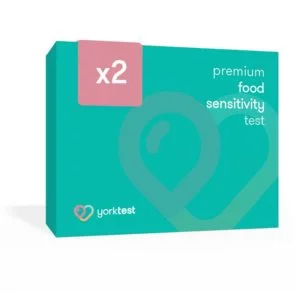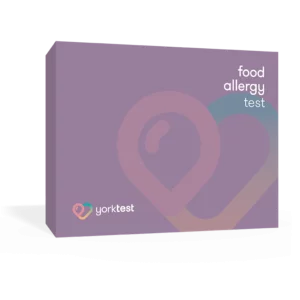- What is an Apple Allergy?
- Signs and Symptoms of Apple Allergy
- Apple Allergy vs Apple Sensitivity
- How to Test for an Apple Allergy
- Skin Prick Test
- Blood Test
- Elimination Diet
- Note on Oral Allergy Syndrome Testing
- Cross-Reactive Foods to Avoid with Apple Allergy
- Treatment for Apple Allergy
- Test for Apple Allergy or Sensitivity with YorkTest
An apple allergy is one of the more complex food allergies to identify – for two main reasons. Firstly, in some individuals, certain apple varieties can trigger more intense allergy symptoms than others. This can cause inconsistent symptoms after consuming apples, making it harder to pinpoint apples as the trigger. Secondly, lots of people who experience an allergic reaction to apples are experiencing Oral Allergy Syndrome (OAS) rather than a specific allergy to apples. OAS is a contact allergic reaction triggered by raw fruit or vegetables coming into contact with the mouth or throat. If you suspect you have a more complex allergy syndrome, then you should seek medical advice from your primary care physician or an allergist.
However, if you think that apples in particular are causing you issues then this guide can help. We’ll outline the symptoms of an apple allergy, highlight other cross-reactive foods you should be mindful of consuming, and ways to test for and manage an apple allergy in your everyday life.
What is an Apple Allergy?
An apple allergy occurs when the body has an immune system response that releases Immunoglobulin E (IgE) antibodies as an adverse reaction to the proteins in apples.
This allergic reaction most commonly occurs when apples are eaten whole. This is thought to be because “Mal d 1” protein (the primary allergen in apples) is found in higher concentrations in the peel. However, lots of people will still experience an allergic reaction when eating peeled apples as Mal d 1 is also found in apple pulp.
Where an apple allergy is linked to OAS, an individual might be able to tolerate cooked apples. This is because heat processing can break down the proteins responsible for OAS symptoms.
Signs and Symptoms of Apple Allergy
The reaction you get from an apple allergy can vary in severity from person to person. These reactions can occur within minutes or up to several hours after consuming apples. Some of the most common signs and symptoms include:
- Mild Symptoms: Itchy mouth and throat and swelling around lips and tongue after eating apples or apple-containing foods. These symptoms are typically noticeable immediately after contact.
- Gastrointestinal Issues: Nausea, vomiting, diarrhea, or abdominal pain might occur due to ingestion of labile allergens present in fresh apples.
- Skin Reactions: Hives, eczema, or contact dermatitis can develop upon direct skin exposure to apple allergens.
- Respiratory Symptoms: In rare cases, individuals with severe apple allergies may experience difficulty breathing, wheezing, or nasal congestion due to an allergic reaction.
- Anaphylaxis: Although extremely rare, anaphylactic shock is a life-threatening reaction that requires immediate medical attention. Symptoms include rapid heartbeat, shortness of breath, dizziness, confusion, swelling of the throat and face, chest pain, and loss of consciousness.
Emergency medical attention should be sought immediately where respiratory symptoms or signs of anaphylaxis occur.
Apple Allergy vs Apple Sensitivity
An apple allergy and an apple sensitivity (intolerance) may present similar symptoms. But the two conditions have different underlying causes. It is important to recognize the distinction between them to allow for proper management.
Here are some of the key differences to remember:
- An apple allergy elicits an IgE antibody immune response whereas an apple sensitivity triggers an IgG antibody response.
- Symptoms of an allergic reaction can begin immediately, or shortly after, contact with a trigger allergen. On the other hand, symptoms of apple sensitivity can take several hours, or even days, to appear.
- Allergic reactions can be life-threatening, requiring immediate medical attention. Sensitivities are generally less severe and may only cause discomfort.
- The typical profile of symptoms differs. Whilst an allergy is linked to swelling, itching and sneezing, an apple sensitivity is more likely to trigger symptoms such as:
- Diarrhea
- Bloating
- Skin conditions e.g. eczema or psoriasis
- Headaches
- Fatigue
If you’re experiencing any of the symptoms on the list above, we recommend taking a Premium Food Sensitivity Test to see whether apples are triggering an IgG reaction in your body.
How to Test for an Apple Allergy
If you suspect that you may have an allergy, you can make an appointment to consult with an allergist. You can also try a Home-to-laboratory Allergy Test Kit to help determine whether or not you have an IgE reaction to apples. Depending on which avenue you take, there are several tests available for diagnosing food allergies.
Skin Prick Test
A skin prick test involves placing a small amount of apple allergen on the skin and then pricking the surface to introduce the substance into your system. If a red bump or hive appears at the site within 15-20 minutes it indicates a possible allergy.
Blood Test
As one of the most reliable testing options, a blood test measures levels of IgE antibodies in response to various allergens, including apples. Elevated levels of IgE antibodies may suggest an apple allergy. Conveniently, food allergy blood tests can be conducted using a finger-prick blood sample, which can be collected from the comfort of one’s home.
Elimination Diet
Another way to pinpoint an allergy is to eliminate apples from your diet for a period of time and later reintroduce them whilst monitoring for symptoms.
The major drawback of using an elimination diet alone is that you can’t differentiate between an allergy and an intolerance. If someone has an apple allergy, then re-introducing that food into their diet could be dangerous.
Note on Oral Allergy Syndrome Testing
If your symptoms seem related specifically to raw apples and don’t occur when eating cooked apples, it might be indicative of Oral Allergy Syndrome. Both skin prick tests and blood tests are generally recommended to properly diagnose this condition.
It is crucial to remember that self-diagnosing an apple allergy or any other food allergy should be done with the oversight or consultation of a qualified healthcare professional. Always seek professional medical advice prior to making major dietary modifications or taking medications for suspected allergies.
Cross-Reactive Foods to Avoid with Apple Allergy
If you have an apple allergy, it’s important to be conscious of consuming not only apples but also other cross-reactive foods that contain similar proteins. Here are some cross-reactive foods related to apple allergy:
- Birch pollen-related fruits: Apples belong to the same family as birch trees and share similar proteins. If you’re allergic to birch pollen, you may also experience symptoms when eating pears, peaches, plums, cherries, apricots, kiwis, or hazelnuts.
- Oral Allergy Syndrome (OAS) trigger foods: OAS is caused by cross-reactivity between certain pollens and raw fruits, vegetables, or nuts. So, in addition to apples, you may want to avoid other common OAS-trigger foods, such as, pears, carrots, celery, parsley, fennel, and spices from the Apiaceae family (e.g., coriander, cumin, dill, aniseed, and caraway). Also be mindful about consuming certain nuts, like almonds, Brazil nuts, and macadamia nuts, as well as seeds like sesame seeds, poppy seeds, and sunflower seeds.
- Processed apple derivatives: Avoid apple juice, apple cider vinegar and apple sauce. Check the ingredients on baked goods, jams and jellies, to ensure they don’t contain apples or apple pectin.
- Non-food products containing apple extracts: Apple peel extract and apple pectin can be used as common ingredients in non-food items like cosmetics and personal care products. This can also include pharmaceuticals, vitamins, supplements, herbal remedies, perfumes, and aromas. which may cause skin irritation/allergic contact dermatitis in sensitive individuals.
Treatment for Apple Allergy
The only way to prevent an allergic reaction is to avoid apples and any food products containing them. However, there are some additional strategies which can help alleviate symptoms or further reduce the risk of a reaction:
- Antihistamines: Over-the-counter antihistamines can help relieve mild allergic reactions such as itching, hives, and swelling. These medications work by blocking the release of histamine, which is responsible for many allergy symptoms.
- Dietary Modifications & Nutrition Counseling: A registered nutritional therapist or dietitian can provide guidance on how to maintain a balanced diet while avoiding apples and other potential cross-reactive foods. They can also suggest alternative sources of nutrients commonly found in apples, such as vitamin C.
- EpiPen (Epinephrine Autoinjector): In extreme cases of anaphylaxis—a severe allergic reaction that can be life-threatening—individuals should carry an EpiPen at all times. This device delivers a dose of epinephrine to counteract the effects of anaphylaxis quickly. Consult your healthcare provider about obtaining an EpiPen if you have a history of severe allergic reactions.
It is essential to consult with a healthcare professional before starting any treatment for an apple allergy. Your doctor will help you determine the best course of action based on your specific symptoms and medical history.
Test for Apple Allergy or Sensitivity with YorkTest
YorkTest specializes in home to laboratory food sensitivity and allergy tests which assess how a person’s immune system reacts to specific foods and drinks.
- Premium Food Sensitivity Test is ideal for adults 18+. The test analyzes an individual’s IgG reactivity to 200 foods and drinks, including apples.
- Junior Food Sensitivity Test is ideal for kids aged 2-17. It also analyzes IgG reactions but has been designed to better suit children’s diets.
- Food Allergy Test is suitable for anyone aged 18+. The test analyzes an individual’s IgE reactivity to 23 foods, as well as 18 common environmental allergens.
To take any test, you can order a kit online – which is then mailed to you within a few days. After collecting a blood sample, you can send it back to YorkTest for free, where it’s analyzed in our accredited laboratory.








